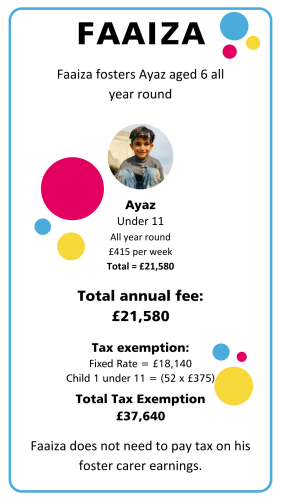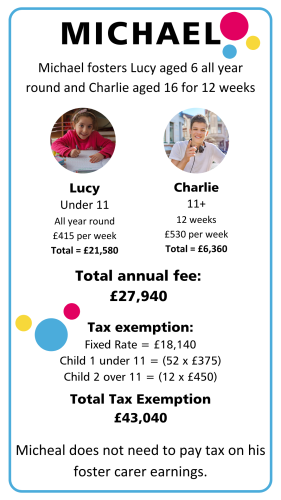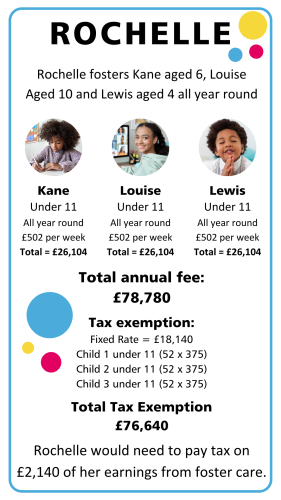


In most cases, foster care income is tax-free due to Qualifying Care Relief. However, every carer’s income is different, so we will guide you through the entire process. From explaining key terms and calculating your income tax threshold to filing your self-assessment tax return and answering your FAQs. At Capstone, we’re here to support you throughout all parts of the fostering process.
Qualifying Care Relief (QCR) is a form of tax relief specifically designed for foster carers and foster care income. Previously known as Foster Care Relief, QCR allows carers to receive tax-free foster care payments until they reach their tax threshold for that year. Each tax year this fixed threshold increases in line with CPI inflation, rounding up to the nearest £10 for the fixed amount and the nearest £5 for the weekly amounts.
But what does this mean for foster carers? For the tax year 2023-2024, carers can receive tax-free income on:
Plus
In turn, many carers pay no tax at all from their fostering income! However, it’s important that carers calculate their unique tax threshold and compare it to their foster care income at the end of each tax year to ensure they’re within their tax threshold.
Click here to learn more about Qualifying Care Relief.
One of the biggest benefits of the Qualifying Care Relief is that it makes calculating your tax liability incredibly easy. All you need to do is compare your foster care income to your tax threshold.
If your fostering income is less than your tax threshold you don’t need to pay any income tax.
Example: Michael fosters Lucy (aged 6) and Charlie (aged 16) all year. He is eligible for a £61,040 tax threshold. He currently receives £41,600 in fostering income. Therefore, he will not pay any income tax.
But how to do you calculate your fostering tax threshold?
To calculate your tax threshold, otherwise known as your tax relief, simply use the following calculation:
QCR’s Fixed Amount + (QCR’s Weekly Amount x Weeks in Care) = Tax Relief
Example: Rochelle is a carer for an 8 year old all year round and a 16 year old for 12 weeks of the year. She does not have to pay tax on the first £43,040 she earns from fostering:
Tax exemption = £18,140 + Child 1 (52 x £375) = £19,500 + Child 2 (12 x £450) = £5,400
Total = £43,040
Do not worry if you exceed the tax threshold! Carers that exceed their threshold will either pay income tax on the excess profit they have made or use their personal tax allowance to offset their tax liability.
Personal tax allowance is the amount of money you’re allowed to earn each year before paying tax. In the UK, standard personal tax allowance is £12,570. Therefore, if you’re a full-time foster carer, with no additional source of income, you can use this personal tax allowance to offset your tax profits - this is in addition to your Qualifying Care Relief. However, you will pay income tax on profits if you earn from other jobs or investments.
Click here to learn more about Personal Tax Allowance.



As foster carers aren’t considered employees of their local authority or fostering agency, they will need to register as self-employed once they become a foster carer. They will also need to file a Self Assessment tax return each year (even if they’re within their tax threshold). Understandably, this can be a daunting prospect for new carers. However, with Qualifying Care Relief, filing your taxes is really quite simple.
(Note: you will need to register as a self employed foster carer and set up an HMRC account before filing your Self Assessment tax return. Read our guide ‘Are Foster Carers Self Employed?’ to learn how to register as self employed.)
Firstly, when filling out your details, it’s important that you put an ‘X’ in the box for ‘if you are a foster carer or shared lives carer’. Next, HMRC will want to know three key metrics:
Once you’ve submitted your details, you’ll be able to review your calculation and see how much income tax you owe (if any). Then all that’s left to do is click submit!
Click here to read more about Self Assessment Tax Returns.
No, you can either file your tax return online or request a paper form (known as the SA100). However, online submissions are preferrable (and simpler).
There are a few different deadlines to be mindful of when submitting your tax return:
If you miss the deadline by up to 3 months, you’ll receive a late filing penalty of £100. If you miss the deadline by more than 3 months you’ll incur additional costs.
If you exceed your tax threshold, your income tax bill should also be paid by midnight on the 31st January 2024. If you miss the deadline, you will be expected to pay interest on your late payments.
A Unique Taxpayer Reference number (or UTR) is a 10-digit code that HMRC use to identify you (or your business) when managing your tax returns. You will receive a UTR when you register as self employed, and you will need this when filling out your tax return each year.
No, filing with Qualifying Care Relief means that you don’t need to keep your fostering recipients unless you have a specialist placement. All you need is your remittance slips and your annual summary.
If you have one or multiple streams of income, you need to declare all of your taxable income for the year in one Self Assessment tax return. Don’t worry if you have already been taxed on your other streams of income, you won’t be taxed twice on the same income.
If you’re fostering as a couple, you can either split your income as a partnership or identify a ‘main carer’ who will declare all of the fostering income. In most cases, couples only register as a partnership if they both work as full time foster carers and their income exceeds their tax threshold. However, each couple is different, so it’s important you make the decision based on your unique circumstances.
Yes – whilst Qualifying Care Relief has made tax returns much simpler, you can hire an accountant if you believe it’s necessary. However, there are several helpful resources available to guide you through the process if you choose to file your taxes yourself.
Whilst we’re committed to supporting our carers throughout every part of the fostering process, we understand that the prospect of filing taxes can be daunting. So, we’ve included some additional resources that may help you through the process:
Our team have created a series of useful resources to help you with all aspects fostering pay - from payments to pensions. Click the links below to answer the following questions:
Foster Talk are a foster care support network that offer guidance, advice and benefits for thousands of foster carers across the UK. As part of their membership, they offer carers specialised tax, benefits and NI advice, along with general financial advice. At Capstone, our foster carers are automatically signed up to Foster Talk when they are approved to foster with us. Click here to book an appointment with Foster Talk to discuss all things tax, National Insurance and benefits.
HMRC have created a guide specifically for foster parents, with section dedicated solely to tax arrangements. Click here to learn more or call them on 0300 200 3300.
To learn more about fostering finances, read our guide ‘How much do Foster Parent’s get Paid?’ Alternatively, contact our helpful team today! We will do our best to answer all your fostering questions.
If you’ve got any questions or would like to find out more about fostering with Capstone, fill out the form below.
An experienced fostering advisor from your local area will then be in touch.
Start the conversation today. Our team of friendly advisors are on hand to answer any foster care questions you may have. We can offer you honest and practical advice that can help you decide if becoming a foster carer is the right path for you.


